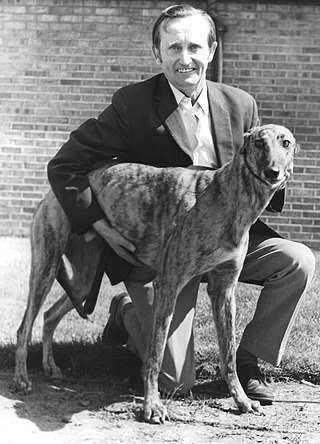Related Research Articles
Romford Greyhound Stadium, referred to as Coral Romford Greyhound Stadium is a greyhound racing track located in Romford town centre in the London Borough of Havering in east London which is owned and operated by the Ladbrokes Coral group. The stadium has a capacity for over 1,700 people.

Wembley Greyhounds was the greyhound racing operation held at Wembley Stadium in London.
The 1929 UK & Ireland Greyhound Racing Year was the fourth year of greyhound racing in the United Kingdom and Ireland.
The 1930 UK & Ireland Greyhound Racing Year was the fifth year of greyhound racing in the United Kingdom and Ireland.
The 1931 UK & Ireland Greyhound Racing Year was the sixth year of greyhound racing in the United Kingdom and Ireland. The total annual attendance across the country for 1931 increased to 17,906,917 from 17,119,120, a fifth consecutive annual increase.
The 1933 UK & Ireland Greyhound Racing Year was the eighth year of greyhound racing in the United Kingdom and Ireland.
The 1936 UK & Ireland Greyhound Racing Year was the 11th year of greyhound racing in the United Kingdom and Ireland.
The 1938 UK & Ireland Greyhound Racing Year was the 13th year of greyhound racing in the United Kingdom and Ireland.
The 1939 UK & Ireland Greyhound Racing Year was the 14th year of greyhound racing in the United Kingdom and Ireland.
The 1943 UK & Ireland Greyhound Racing Year was the 18th year of greyhound racing in the United Kingdom and Ireland.
The 1945 UK & Ireland Greyhound Racing Year was the 20th year of greyhound racing in the United Kingdom and Ireland.
The 1948 UK & Ireland Greyhound Racing Year was the 23rd year of greyhound racing in the United Kingdom and Ireland.

The 1971 UK & Ireland Greyhound Racing Year was the 45th year of greyhound racing in the United Kingdom and Ireland.

The 1972 UK & Ireland Greyhound Racing Year was the 46th year of greyhound racing in the United Kingdom and Ireland.

The 1976 UK & Ireland Greyhound Racing Year was the 50th year of greyhound racing in the United Kingdom and Ireland.

The 1979 UK & Ireland Greyhound Racing Year was the 53rd year of greyhound racing in the United Kingdom and Ireland.
The 1980 UK & Ireland Greyhound Racing Year was the 54th year of greyhound racing in the United Kingdom and Ireland.
The 1981 UK & Ireland Greyhound Racing Year was the 55th year of greyhound racing in the United Kingdom and Ireland.
Jim Manoel Syder Jr. (1911-1972) was an English greyhound trainer. He achieved the highest training accolade when winning the English Greyhound Derby.
James Platten Syder, known as Jim Syder Sr. (1880-1945) was an English greyhound trainer. He achieved the highest training accolade when winning the English Greyhound Derby.
References
- ↑ Fry, Paul (1995). The Official NGRC Greyhound Racing Yearbook. Ringpress Books. ISBN 186054-010-4.
- 1 2 Dack, Barrie (1990). Greyhound Derby, the first 60 years. Ringpress Books. pp. 74–75. ISBN 0-948955-36-8.
- 1 2 Comyn, John. 50 Years of Greyhound Racing in Ireland. Aherlow Publishers Ltd.
- ↑ Hobbs, Jonathan (2007). Greyhound Annual 2008, pages 153-154. Raceform. ISBN 978-1-905153-53-4.
- ↑ Genders, Roy (1981). The Encyclopedia of Greyhound Racing, pages 129-130. Pelham Books Ltd. ISBN 07207-1106-1.
- 1 2 ""Greyhound Racing Association Trust." Times, 1 Feb. 1938". The Times . February 1938. p. 20.
- ↑ "OUR SPECIAL CORRESPONDENT. "Greyhound Racing." Times [London, England] 28 June 1937". The Times .
- ↑ "1937". Greyhound Data.
- 1 2 3 4 Genders, Roy (1981). The Encyclopedia of Greyhound Racing. Pelham Books Ltd. ISBN 07207-1106-1.
- ↑ "Greyhound Star (Remember When November)". Greyhound Star. 16 November 2016.
- ↑ Tarter, P Howard (1949). Greyhound Racing Encyclopedia. Fleet Publishing Company Ltd.
- ↑ Genders, Roy (1975). The Greyhound and Racing Greyhound. Page Brothers (Norwich). ISBN 0-85020-0474.
- 1 2 3 Genders, Roy (1990). NGRC book of Greyhound Racing. Pelham Books Ltd. ISBN 0-7207-1804-X.
- ↑ Barnes, Julia (1988). Daily Mirror Greyhound Fact File. Ringpress Books. ISBN 0-948955-15-5.
- ↑ Barnes, Julia (1991). Daily Mirror Greyhound Fact File, Vol Two. Ringpress Books. ISBN 0-948955-61-9.
- ↑ Barnes/Sellers, Julia/John (1992). Ladbrokes Greyhound Fact File. Ringpress Books. ISBN 0-948955-22-8.
- ↑ Fortune, Michael. Irish Greyhound Derby 1932-1981. Victory Irish Promotions Ltd.
- ↑ Fortune, Michael. "The 75 Years History of the Irish Greyhound Derby". Irish Greyhound Review. ISSN 0332-3536.
- ↑ "K. C. Gandar Dower. "Racing Cheetahs." Times [London, England] 11 Dec. 1937". Times [London, England] 15 Oct. 1927: 6. The Times Digital Archive.
- ↑ ""Cheetah Versus Greyhound." Times [London, England] 13 Dec. 1937". The Times .